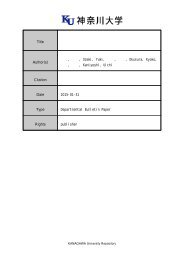to Learners with Special Educational Needs
e-textbook SEN
e-textbook SEN
Create successful ePaper yourself
Turn your PDF publications into a flip-book with our unique Google optimized e-Paper software.
Pokrivčáková, S. et al. (2015). Teaching Foreign Languages <strong>to</strong> <strong>Learners</strong> <strong>with</strong> <strong>Special</strong> <strong>Educational</strong> <strong>Needs</strong>:<br />
e-textbook for foreign language teachers. Nitra: Constantine the Philosopher University. 128 p.<br />
ISBN 978-80-558-0941-0<br />
(www.improvinghealthandlives.org.uk, www.bild.org.uk, www.bris.ac.uk/cipold) it is obvious<br />
that there is a difference in meaning in American and British terminology. In the USA the term<br />
´learning disability´ is used <strong>to</strong> cover several specific learning disorders particularly in relation <strong>to</strong><br />
reading, writing and math, such as dyslexia, dyspraxia and dyscalculia. In American references,<br />
terms like ´intellectual disabilities ´and ´mental retardation´ are commonly used as labels <strong>to</strong><br />
describe what people in UK would understand as learning disabilities. In comparison, the UK<br />
uses several definitions of learning disabilities. These usually include the presence of:<br />
A significantly reduced ability <strong>to</strong> understand new or complex information or <strong>to</strong> learn new skills;<br />
A reduced ability <strong>to</strong> cope independently;<br />
An impairment that started in childhood <strong>with</strong> an effect on development.<br />
In general a person finds difficult <strong>to</strong> understand, learn and remember new things, and means<br />
that the person may have problems <strong>with</strong> a range of things such as managing everyday tasks and<br />
communication (QCF, n.d., p. 4).<br />
British literature recognizes several levels of learning disabilities. The continuum of learning<br />
ability ranges from mild learning disability, continuing <strong>with</strong> moderate and severe, finishing <strong>with</strong><br />
profound learning disability. <strong>Learners</strong> suffering from severe learning disability use only basic<br />
words and gestures in order <strong>to</strong> communicate their needs. People <strong>with</strong> a profound learning<br />
disorder are considered <strong>to</strong> be the most disabled individuals in the community. Their intellectual<br />
quotient is estimated lower than 20, therefore they need special educational centers in order <strong>to</strong><br />
be taught.<br />
<strong>Learners</strong> <strong>with</strong> a moderate learning disability are likely <strong>to</strong> have some language skills. They are<br />
able <strong>to</strong> communicate about their needs and wishes. They may need some support <strong>with</strong> caring for<br />
themselves but they succeed in carrying out daily tasks. A mild learning disability is often not<br />
diagnosed. <strong>Learners</strong> may need some support <strong>to</strong> understand abstract or complex ideas. They are<br />
quite independent in caring for themselves and carrying out given tasks (QCF, n.d.)<br />
Following the Slovak legislation, inclusive classrooms in Slovakia cover learners <strong>with</strong> health<br />
impairment, learners <strong>with</strong> learning disorders, attention disorders, gifted children, and children<br />
from socially deprived families. Inclusive schooling is realized in classrooms <strong>with</strong> other learners<br />
and if necessary such a learner is educated <strong>with</strong>in the individual educational program<br />
elaborated by school in cooperation <strong>with</strong> appropriate professional educational institution (SSI,<br />
2012, translated by the author). Unfortunately, as Pokrivčáková (2013, p. 120) reveals that<br />
“institutional research on teaching foreign languages <strong>to</strong> learners <strong>with</strong> special educational needs in<br />
Slovakia is extremely rare, or even non-existent.” Therefore, as the author later on claims, there is<br />
a limited number of publications on the <strong>to</strong>pic as the obvious consequence of the lack of complex and<br />
determined research (ibid.). She later on recommends discussing the latest progress in the field<br />
among wider professional public in order <strong>to</strong> prepare either teachers or teachers <strong>to</strong> be for the<br />
real life situation in our schools.<br />
For the purposes of this paper, the discussed target groups of learners are ranged in<strong>to</strong> mild<br />
and moderate learning disabilities in British environment and according <strong>to</strong> American definition,<br />
the learning disorders like dyslexia, dysorthographia, dyspraxia, dyscalculia, Asperger<br />
syndrome, ADHD learners are covered. However, Slovak terms for learning disabilities and<br />
disorders are widely used in the papers and books.<br />
Differences in English learning<br />
Kormos and Smith (2012) claim that around 10 per cent of students exhibit a specific<br />
learning difference. That means that they have difficulties <strong>with</strong> acquisition of literacy-related<br />
skills(dyslexia), numeracy (dyscalculia), the coordination of movement (dyspraxia), sustained<br />
attention(ADHD) and social interaction(Asperger´s syndrome). Thus, it is very likely <strong>to</strong> have at<br />
least 2 different learners in the classroom <strong>with</strong> 20 pupils.<br />
The term learning difference does not seem <strong>to</strong> convey the negative meaning such as learning<br />
difficulty or disorder, and therefore it will be used in this paper in order <strong>to</strong> cover all the above<br />
mentioned learning syndromes. Our aim is not <strong>to</strong> describe particular differences as these are<br />
30






